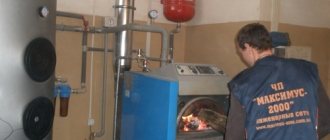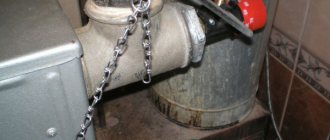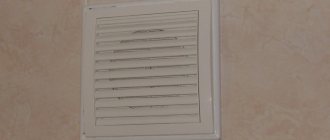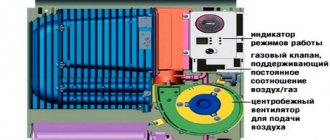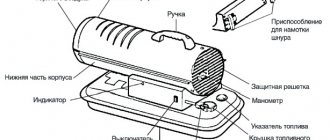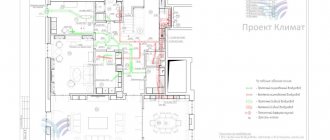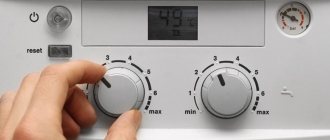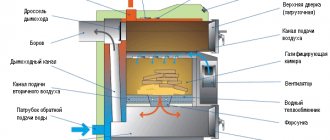Principle of operation
The water fan heater is constructed of a housing, inside of which there is a heat exchanger and a fan.
Using blades, the fan generates an air flow that is heated by a heat exchanger with circulating hot water and thus increases the air temperature in the room. This device is highly efficient with fairly low power consumption. In addition, the water fan heater is easy to maintain, and the only part that can fail is the fan. Among other advantages, an undoubted advantage in the operation of such a device is its high fire safety.
Design and installation requirements for water fan heater Zilon HP-60.000W
The essence of the heater
In terms of its functionality and operating principle, a heater is a furnace that includes a heating unit and a fan. The heater transfers heat to the water, and the fan circulates air through the system, which takes the heat from the water and releases it to the room. To operate such a furnace, a variety of fuels can be used; a popular solution is to operate the heater on the exhaust; the exhaust is quite cheap and at the same time effective as a fuel.
Water heater diagram:
The heater design includes the following elements:
- heating element body;
- aluminum plates on copper tubes;
- pipe manifolds for supplying and draining water;
- plugs for wallpaper collectors;
- system for connecting pipes to the heater.
A fan is installed behind the heating block, which blows air through the heater. The air is instantly heated by the aluminum plates and exits into the room already heated.
Varieties
The main criteria on the basis of which water fan heaters are distinguished are the size and power of both the heating element and the fan.
Water fan heater EuroHeat Volcano V20
Power ratings range from 2 to 90 kW. Thanks to such a wide range, many models with low power can be used at home, in any case it will be economically beneficial, because Electricity is only needed to operate the fan.
According to the housing design, water fan heaters can be floor-mounted or wall-mounted.
Wall-mounted models are equipped with a special mounting console, thanks to which you can adjust the vertical position of the device and direct the flow of hot air where you need it.
Installation of such units is simple: you need to fix the console on the wall using anchor bolts and connect the water circuit to the fan heater itself.
If you have basic technical knowledge, then you can handle the installation yourself, without the help of specialists.
Floor-standing models do not need to be fixed or secured; they just need to be connected to the water supply. Therefore, they can be installed anywhere and, if necessary, moved.
The price of fan heaters depends on the power of the device.
What types of fan heaters are there?
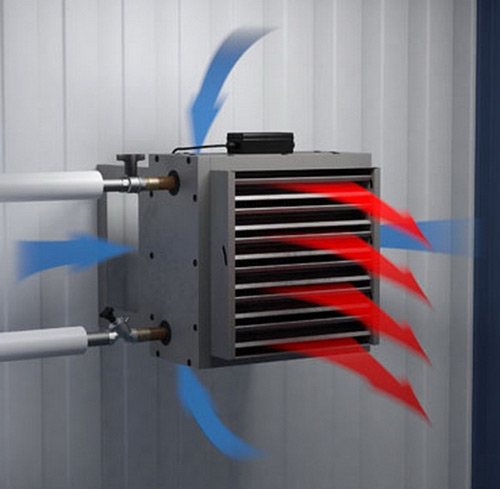
Hot water fan models are available with a power of 2 – 90 kW. Such a wide power range makes it possible to choose a decent and efficient copy for almost any room, be it an apartment or a garage.
Depending on the design features of the housing, there are 2 types of fan heaters.
- Floor-standing – they move absolutely freely throughout the entire area of the room.
- Wall-mounted - placed on a durable console that holds the unit in a strictly vertical position.
There are also models that have 2 circuits. These units can usually be used to heat a room; they are also used as air conditioners, that is, they are capable of cooling a room. Such double-circuit fan heaters are connected to two water supply systems: one to the hot one, the second to the cold one, respectively.
Advantages
Heating using fan heaters has a number of advantages, including:
- Heat efficiency. The heat that emanates does not rise to the ceiling and does not heat the walls, as is the case with a conventional heating system, but immediately warms up the lower layers of air in the room.
- Safety. Such devices meet fire safety standards, and thanks to the protective box, the risk of burns is eliminated,
- Adjustable power and intensity.
When installing a water heater, pay special attention to its location. After all, the effectiveness of the device will depend on this.
The fan heater should be placed in a place from which the heated air will be distributed as far as possible.
Operating conditions
The installation can be operated at temperatures from -10°C to +40°C. Air humidity should be no more than 80% at a temperature of +20.
Do not use the fan in an excessively dusty environment (10 mg/m³). The unit must not be installed in a room where the air contains aggressive substances, technical fibers, resins and drip moisture.
The coolant for the installation is superheated or hot water with the following indicators: temperature no more than 150°C, operating pressure should not exceed 1.2 MPa.
The installation is controlled by a remote control, which is included in the kit. If there is a mixing option, a certain air temperature is maintained and power and productivity are regulated. Only identical fan heaters are controlled from one remote control. The total current through the remote control is no more than 2 A.
Sometimes standard devices for heating the space are not enough, especially if there are small children in the house. That is why in winter a small fan heater is used to heat the apartment. It is even more economical than a set of several conventional heaters.
The only and not particularly significant drawback of the unit is its limited use in industrial applications due to the need for a hot water supply. But this disadvantage is found in most heaters.
How to make it yourself
To make a water fan heater with your own hands, you need to acquire the following parts:
- sheet of galvanized metal or stainless steel, the thickness of which is 1 mm; the body will be made from it;
- copper tube for heat exchanger;
- two end valves with couplings; using these devices, the heat exchanger will be connected to the central heating system;
- fan;
- four springs, they are designed to secure the fan.
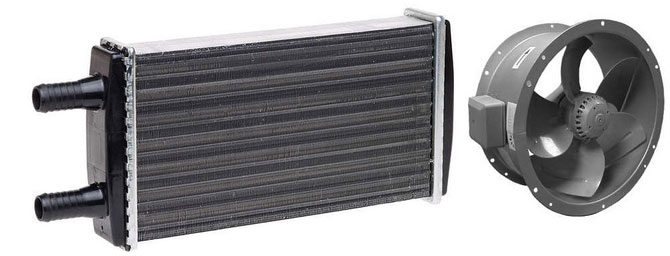
Heat exchanger and fan for water heater
Assembly:
- At the first stage, markings are made. Using a jigsaw or grinder, you need to cut out a strip of metal and use it to build an impromptu frame.
- Then you need to mark the fold lines on the strip.
- The opposite ends of the strip are connected with bolts; to do this, a flange of 1-2 cm must be made at both ends of the strip.
- The remaining material is used to make the front panel, in which many large holes need to be drilled to allow hot air to escape.
- The panel is then attached to the front of the frame.
- The copper pipe must be filled with clean sand, then one end must be plugged and the heat exchanger must be bent.
- At the next stage, the heat exchanger must be cleaned of sand and blown well.
- Two holes are drilled on the side of the body.
- At the ends of the heat exchanger, threads are cut for connection to the couplings.
- A Mayevsky tap is soldered into the upper point of the heat exchanger.
- A heat exchanger is inserted into the finished housing and secured to it with nuts.
- The next step is to install the fan.
- Next, the device is mounted on the wall so that the distance between the wall and the heater is 10 cm or more.
- At the final stage, taps are connected to the central heating pipes and connected to the fan through couplings.
The water heater is ready!
A gas or diesel heat gun can also be used to heat industrial premises.
Device
A water-based industrial heat fan is a device that generates heat from hot water, which is supplied by a fan. The equipment does not require connection to a gas pump, boiler or other energy source. In another way, such a device is also called a heater. Unlike heating radiators, the heater heats the room faster due to the air jet pushed out of the device for exchanging contrast-temperature media by an electric fan.
Its device has the following components:
- body made of heat-resistant material (plastic, metal);
- heat exchanger - an internal device that allows the exchange of different temperature environments to heat the air;
- fan with electric motor;
- grille-blinds - protects the structure from the outside and supplies directional flow by adjusting the plates;
- temperature controllers;
- speed controllers;
- thermostat;
- conductor part - pipes;
- connecting part (fastenings, power cord);
- insulating material to protect against dust and moisture.
Operating principle of the device:
- The coolant is hot water, taken from a hot water supply or from a central heating system and supplied through pipes to the compartment where different temperatures are exchanged.
- The pipes heat up, thereby heating the air in the compartment.
- The fan pushes out the heated air.
- Rotating blinds direct the flow in the desired direction.
The grille in some models may be stationary, without rotating mechanisms. This means that the direction of the thermal air flow will only be in one direction. The pushing force is created by the power of the fan - the more powerful this device, the further the jet will reach the space. The supply temperature can be different - from a warm stream to a hot stream.
To use the fan heater correctly, you will need special installation of the structure. The installation is not portable, so it needs to be attached to the wall (less often, to the ceiling). In addition, a connection to the coolant is also carried out, which means the placement of pre-provisioned communications - pipes coming from heating radiators or from the water supply network.
Manufacturers
| Manufacturer | Model | Characteristic |
| Teplomash (Russia) | KEV 25 T3W2 | Generates from 3 to 10 kW of thermal power, consuming 0.03-0.11 liters of coolant per second. The fan provides an 8-meter length of warm air jet (30-40 degrees Celsius), supplied in a volume of up to 1200 m³/hour. The permissible installation height is 3-4 meters. Cost – up to 40 thousand rubles. |
| Teplomash (Russia) | KEV T5.6W3 | Generates 45-120 kW of thermal power, consuming from 0.4 to 1.06 liters of coolant per second. The length of the warm jet is 27 meters, the air supply is 3.8-7.2 thousand m³/hour. The permissible installation height is 5-8 meters. Cost – up to 100 thousand rubles. |
| EuroHeat (Poland) | Volcano | Generates from 10 to 60 kW of thermal power, heating a 25-meter air stream to a temperature of 40 degrees Celsius. The heat exchanger volume of this heating device is 3.1 liters, the fan motor power is 530 Watts. Air consumption – 5500 “cubes” per hour. Another distinctive feature of the EUROHEAT Volcano is the polymer housing, which reduces the weight and cost of the product. Cost – 28 thousand rubles. |
| Ballu (China) | BHP-W-60 | Generates up to 60 kW of thermal power, “shooting” a stream of warm air at 25 meters. Fan capacity – 5000 m³/hour. Engine power – 420 watts. The temperature of the outgoing (heated) flow is 23-55 degrees Celsius. The volume of the heat exchanger is 2.3 liters. Installation height – up to 8 meters. Cost – 35-40 thousand rubles. |
As you can see, a water fan heater is capable of creating comfortable conditions in large rooms.
Care instructions
In order for water heat fans to serve for a long time, you need to follow some rules. The surface of the device body is periodically wiped from dust with a soft cloth soaked in a solution of vinegar or soda. The grates where dust is drawn in are cleaned with a vacuum cleaner. Before cleaning, the device must be disconnected from the power supply and wait until it has cooled down.
Particular attention should be paid to fire safety rules when operating the fan. You cannot connect it to the network without grounding. Do not use the device in a room where air humidity exceeds 93%, or near water. Do not operate the fan in explosive environments (gas stations, warehouses for chemicals, paints and varnishes).
The fan must be handled with care and do not drop or break it.
When disconnecting from the power supply, do not pull it by the cord. It is recommended to check the integrity of the wire every time you turn it on. In contact with
Operating principle
The principle of operation of a fan heater with a water heat source is in many ways similar to the principle of operation of a heat gun, in which hot air is accelerated by a powerful fan, creating a thermal jet and ensuring high operating intensity. In the case of a fan heater, the role of heating is performed by hot water, and it comes from the central heating system, so such a device, in terms of additional costs, only requires electricity to ensure the operation of the fan, which expels the hot air outside.
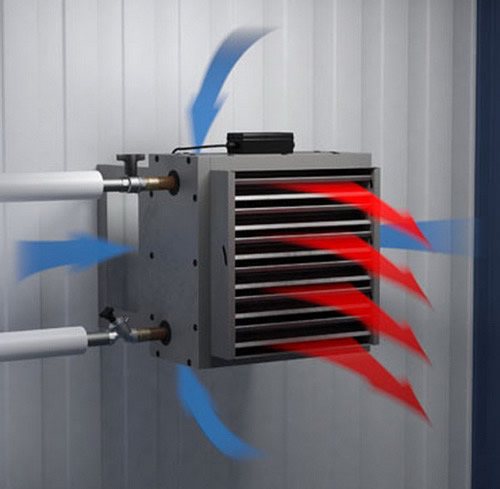
This device makes heating workspaces the least expensive and troublesome, because to put it simply, a water fan heater is a standard hot heating battery, placed in a special protective box and equipped with powerful fans. Therefore, to operate such a device, it is not necessary to obtain additional knowledge and master complex safety precautions, because individually all the components of a water fan heater are familiar to most people in everyday life. Also, no additional knowledge and skills are required to create an industrial heating system from fan heaters; you just need to have a rough idea of how the temperature is distributed in the room and you can do everything yourself.
